-
 Bitcoin
Bitcoin $116900
0.00% -
 Ethereum
Ethereum $4280
5.48% -
 XRP
XRP $3.265
-1.45% -
 Tether USDt
Tether USDt $1.000
-0.01% -
 BNB
BNB $807.0
1.41% -
 Solana
Solana $183.1
2.93% -
 USDC
USDC $0.9999
0.00% -
 Dogecoin
Dogecoin $0.2440
6.50% -
 TRON
TRON $0.3357
-0.88% -
 Cardano
Cardano $0.8178
2.63% -
 Hyperliquid
Hyperliquid $44.13
7.45% -
 Chainlink
Chainlink $21.39
9.09% -
 Stellar
Stellar $0.4524
-0.84% -
 Sui
Sui $3.957
2.13% -
 Bitcoin Cash
Bitcoin Cash $572.7
-2.54% -
 Hedera
Hedera $0.2671
1.54% -
 Avalanche
Avalanche $24.77
4.17% -
 Ethena USDe
Ethena USDe $1.001
0.02% -
 Litecoin
Litecoin $122.3
-1.94% -
 Toncoin
Toncoin $3.432
2.26% -
 UNUS SED LEO
UNUS SED LEO $9.007
0.49% -
 Shiba Inu
Shiba Inu $0.00001396
5.26% -
 Uniswap
Uniswap $11.09
1.64% -
 Polkadot
Polkadot $4.155
4.57% -
 Dai
Dai $1.000
0.00% -
 Pepe
Pepe $0.00001253
5.11% -
 Cronos
Cronos $0.1588
2.67% -
 Bitget Token
Bitget Token $4.512
0.05% -
 Monero
Monero $275.0
0.64% -
 Ethena
Ethena $0.7527
15.10%
Is USDT suitable for long-term holding? Will it depreciate?
USDT's suitability for long-term holding is uncertain due to transparency issues and regulatory risks, which could lead to depreciation despite its stablecoin nature.
May 10, 2025 at 04:14 am
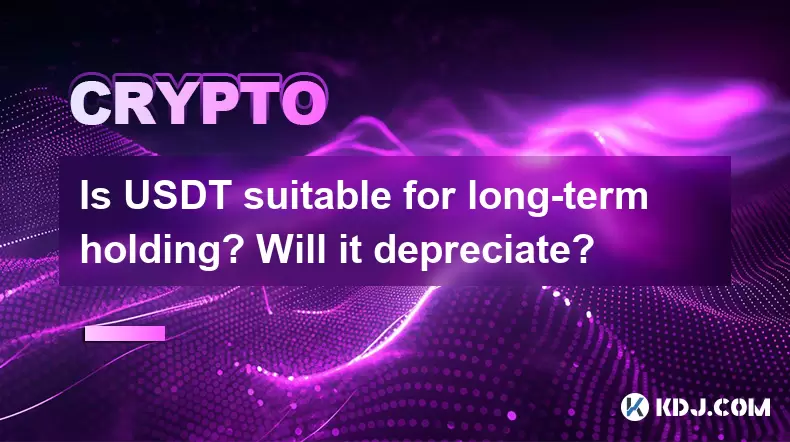
The question of whether USDT (Tether) is suitable for long-term holding and whether it will depreciate is a complex one that requires a deep dive into the nature of stablecoins, the specifics of USDT, and the broader cryptocurrency market dynamics. Let's explore these aspects in detail.
Understanding USDT and Stablecoins
USDT, also known as Tether, is a type of cryptocurrency known as a stablecoin. Stablecoins are designed to minimize the volatility typically associated with cryptocurrencies like Bitcoin and Ethereum. The primary goal of USDT is to maintain a stable value, pegged to the US dollar at a 1:1 ratio. This stability is achieved through various mechanisms, including holding reserves of US dollars or other assets that back the value of the issued tokens.
The Mechanism Behind USDT's Stability
USDT's stability is maintained through a combination of reserve backing and market operations. Tether Limited, the company behind USDT, claims that each USDT token is backed by an equivalent amount of US dollars held in reserve. These reserves are supposed to be held in traditional bank accounts, and Tether periodically releases attestations to verify the backing of their tokens. However, the transparency and reliability of these attestations have been a subject of scrutiny and debate within the crypto community.
Risks and Concerns with USDT
Despite its intended stability, there are several risks and concerns associated with holding USDT long-term. One major concern is the lack of full transparency regarding Tether's reserves. Critics argue that the company has not provided sufficient proof that their reserves are fully backed by US dollars. This lack of transparency can lead to doubts about the true value of USDT and its ability to maintain its peg in times of market stress.
Another risk is the potential for regulatory action. Governments and financial regulators around the world are increasingly scrutinizing stablecoins. If Tether were to face regulatory challenges or if new regulations were to be imposed on stablecoins, it could impact the stability and value of USDT.
Historical Instances of USDT Depreciation
There have been instances in the past where USDT has temporarily lost its peg to the US dollar. In 2017 and 2018, there were several occasions where USDT briefly traded below $1 due to concerns about Tether's reserves and the overall health of the cryptocurrency market. These events highlight the potential for USDT to depreciate, even if only temporarily, under certain conditions.
Comparing USDT to Other Stablecoins
When considering USDT for long-term holding, it's useful to compare it to other stablecoins. USDC (USD Coin) and DAI are two other popular stablecoins that also aim to maintain a 1:1 peg to the US dollar. USDC is backed by a combination of US dollars and short-term US Treasury bonds, and it is subject to regular audits by a third party. DAI, on the other hand, is a decentralized stablecoin that maintains its peg through a system of collateralized debt positions and algorithmic adjustments.
Each of these stablecoins has its own set of risks and benefits. USDC's regular audits and more transparent reserve backing may make it a more appealing option for some investors. DAI's decentralized nature and algorithmic stability mechanism offer a different approach to maintaining value. Understanding these differences can help investors make more informed decisions about which stablecoin, if any, is suitable for long-term holding.
The Role of USDT in the Cryptocurrency Ecosystem
USDT plays a significant role in the broader cryptocurrency ecosystem. It is widely used as a trading pair on cryptocurrency exchanges, allowing traders to move in and out of other cryptocurrencies without converting back to fiat currency. This liquidity and ease of use make USDT a popular choice for many traders and investors.
However, the suitability of USDT for long-term holding depends on an investor's specific goals and risk tolerance. For those looking for a stable store of value within the cryptocurrency space, USDT can serve as a temporary holding place. But for long-term investment, the risks associated with its lack of transparency and potential regulatory challenges may outweigh its benefits.
Potential for Depreciation
The potential for USDT to depreciate is closely tied to the factors mentioned earlier, such as the transparency of its reserves and regulatory risks. If Tether were unable to maintain the 1:1 peg due to insufficient reserves or regulatory action, USDT could lose value. Additionally, broader market conditions and sentiment towards cryptocurrencies can also impact USDT's stability.
In times of extreme market volatility or crisis, even stablecoins can experience fluctuations. If investors lose confidence in Tether's ability to maintain its peg, they may rush to redeem their USDT for other assets, leading to a potential depreciation.
Conclusion on Long-Term Holding
Given the complexities and risks associated with USDT, whether it is suitable for long-term holding depends on an individual's investment strategy and risk tolerance. For those who prioritize stability and are willing to accept the risks associated with Tether's lack of transparency, USDT can serve as a temporary holding place within the cryptocurrency ecosystem. However, for those seeking a more secure long-term investment, other stablecoins or traditional financial instruments may be more appropriate.
Frequently Asked Questions
Q: Can USDT be used for everyday transactions?
A: Yes, USDT can be used for everyday transactions, especially in regions where cryptocurrencies are widely accepted. Many merchants and service providers accept USDT as a form of payment due to its stability and ease of use. However, the acceptance of USDT can vary by location and the specific merchant's policies.
Q: How does USDT compare to holding actual US dollars in a bank account?
A: Holding USDT is different from holding actual US dollars in a bank account in several ways. USDT is a digital asset that exists on the blockchain, which means it can be transferred quickly and without the need for traditional banking infrastructure. However, it also comes with the risks associated with cryptocurrencies, such as potential regulatory changes and the need to trust Tether's reserve backing. In contrast, holding US dollars in a bank account is generally considered more secure and is backed by government insurance in many countries.
Q: What happens if I want to convert my USDT back to fiat currency?
A: Converting USDT back to fiat currency typically involves using a cryptocurrency exchange that supports USDT withdrawals. Here are the steps you would generally follow:
- Choose a reputable exchange that supports USDT and fiat currency withdrawals.
- Transfer your USDT to the exchange's wallet.
- Initiate a withdrawal to your bank account or another payment method supported by the exchange.
- Complete any necessary verification steps required by the exchange to process the withdrawal.
The process can vary depending on the exchange and the specific regulations in your country, so it's important to check the requirements beforehand.
Q: Are there any fees associated with holding or transacting with USDT?
A: Yes, there can be fees associated with holding and transacting with USDT. These fees can include:
- Transaction fees on the blockchain network where USDT is issued (e.g., Ethereum or Tron).
- Exchange fees when buying, selling, or withdrawing USDT on a cryptocurrency exchange.
- Network fees for transferring USDT between wallets.
The specific fees can vary depending on the platform and the type of transaction, so it's important to review the fee structure of any service you use with USDT.
Disclaimer:info@kdj.com
The information provided is not trading advice. kdj.com does not assume any responsibility for any investments made based on the information provided in this article. Cryptocurrencies are highly volatile and it is highly recommended that you invest with caution after thorough research!
If you believe that the content used on this website infringes your copyright, please contact us immediately (info@kdj.com) and we will delete it promptly.
- XRP Price, Remittix, and Ripple Rivals: A Crypto Cocktail
- 2025-08-10 10:50:16
- Riding the Wave: Ethereum, DeFi, and the Liquid Staking Derivatives (LSDs) Surge
- 2025-08-10 10:30:15
- Strobe Ventures, ENA Tokens, and the Surge: What's the Deal?
- 2025-08-10 10:35:15
- Shiba Inu, Pepe, and Remittix: A Tale of Memes, Hype, and Real-World Utility
- 2025-08-10 08:30:12
- Ethereum Price, ETH Tokens, Rally Prediction: Is a New All-Time High In Sight?
- 2025-08-10 08:30:12
- XRP, Elon Musk, and Wealth: A Crypto Conundrum
- 2025-08-10 08:50:12
Related knowledge

How to choose a reliable USDT exchange service provider? How to identify?
Jun 12,2025 at 03:15pm
Understanding the Role of USDT in Cryptocurrency TradingUSDT (Tether) is one of the most widely used stablecoins in the cryptocurrency market. It is d...
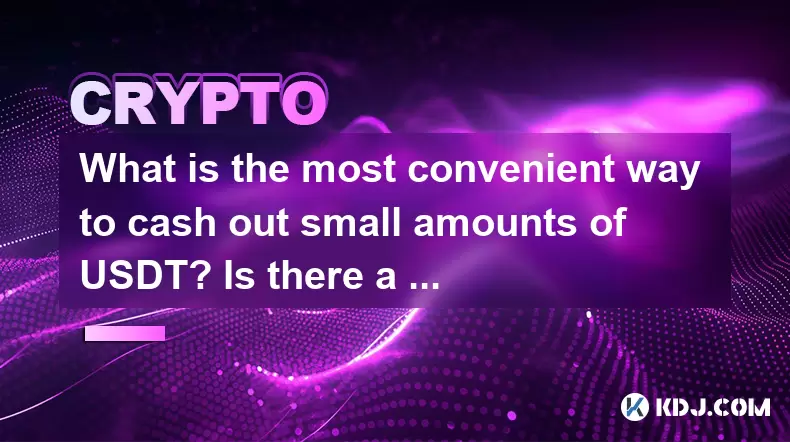
What is the most convenient way to cash out small amounts of USDT? Is there a shortcut?
Jun 11,2025 at 11:00pm
Understanding the Need to Cash Out Small USDT AmountsCashing out small amounts of USDT can be a challenge for many crypto users. Traditional methods o...
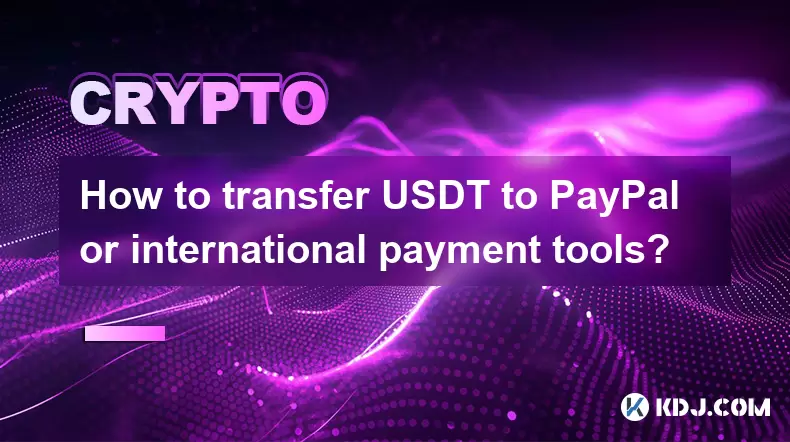
How to transfer USDT to PayPal or international payment tools?
Jun 15,2025 at 05:28am
Understanding the Basics of USDT and PayPal IntegrationUSDT (Tether) is a stablecoin pegged to the US dollar, offering blockchain-based value transfer...
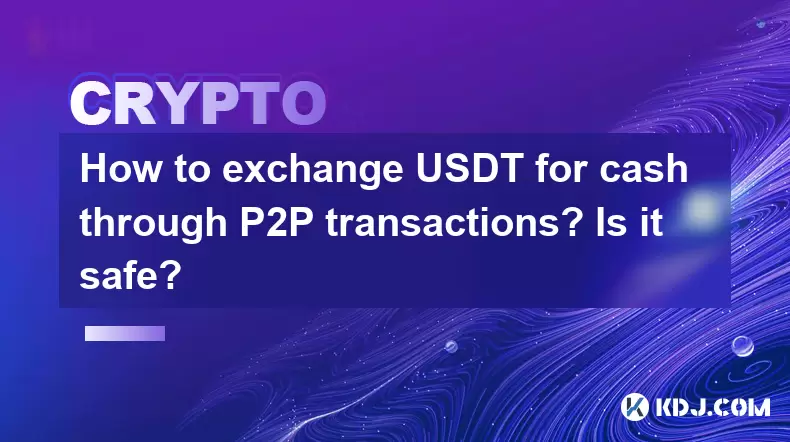
How to exchange USDT for cash through P2P transactions? Is it safe?
Jun 18,2025 at 07:56am
Understanding USDT and P2P TransactionsTether (USDT) is a stablecoin pegged to the value of the US dollar, making it a popular choice for users who wa...
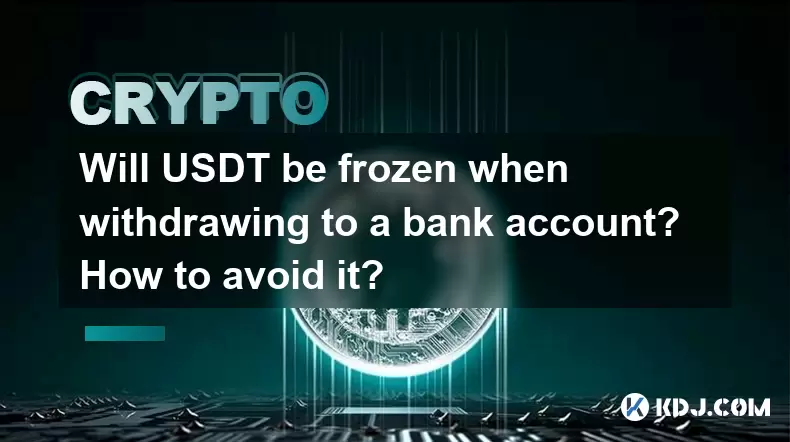
Will USDT be frozen when withdrawing to a bank account? How to avoid it?
Jun 15,2025 at 10:03am
Understanding USDT Withdrawals and Bank Account Freezing RisksWhen users decide to withdraw USDT (Tether) to a bank account, one of the most common co...

How to avoid risks when exchanging USDT for cash? What are the pitfalls?
Jun 11,2025 at 08:14pm
Understanding the Risks of Exchanging USDT for CashWhen exchanging USDT (Tether) for cash, users must be aware of the potential risks involved. As a s...

How to choose a reliable USDT exchange service provider? How to identify?
Jun 12,2025 at 03:15pm
Understanding the Role of USDT in Cryptocurrency TradingUSDT (Tether) is one of the most widely used stablecoins in the cryptocurrency market. It is d...

What is the most convenient way to cash out small amounts of USDT? Is there a shortcut?
Jun 11,2025 at 11:00pm
Understanding the Need to Cash Out Small USDT AmountsCashing out small amounts of USDT can be a challenge for many crypto users. Traditional methods o...

How to transfer USDT to PayPal or international payment tools?
Jun 15,2025 at 05:28am
Understanding the Basics of USDT and PayPal IntegrationUSDT (Tether) is a stablecoin pegged to the US dollar, offering blockchain-based value transfer...

How to exchange USDT for cash through P2P transactions? Is it safe?
Jun 18,2025 at 07:56am
Understanding USDT and P2P TransactionsTether (USDT) is a stablecoin pegged to the value of the US dollar, making it a popular choice for users who wa...

Will USDT be frozen when withdrawing to a bank account? How to avoid it?
Jun 15,2025 at 10:03am
Understanding USDT Withdrawals and Bank Account Freezing RisksWhen users decide to withdraw USDT (Tether) to a bank account, one of the most common co...

How to avoid risks when exchanging USDT for cash? What are the pitfalls?
Jun 11,2025 at 08:14pm
Understanding the Risks of Exchanging USDT for CashWhen exchanging USDT (Tether) for cash, users must be aware of the potential risks involved. As a s...
See all articles

























































































